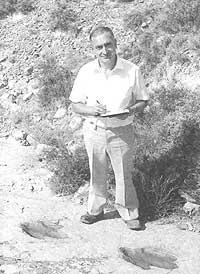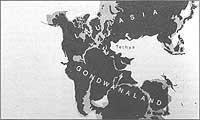Talk with Arantzadi
1988/10/01 Martinez Lizarduikoa, Alfontso Iturria: Elhuyar aldizkaria
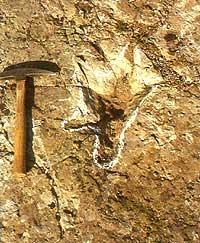
– Above all we are three people who work in this work: Luis Miguel Agirrezabala, José Ángel Torres and Luis Ignacio Viera. But occasionally we have the collaboration of other people, especially when it comes to doing field work.
– How do you work? Do you have any help or grant?– No. We don't have any grants and the studies we do don't pay us. We study this area because it is interesting, spectacular and largely unknown, and that means travel, food, etc. we paid them. We do field work on vacation and when we have free time. It is clear, therefore, that our possibilities are limited and that we do not live from research.
– When did these investigations begin?– We started in paleontology twelve years ago. That is when we began to study the different iknological deposits of the Sierra de Cameros, in the provinces of La Rioja and Soria. It all began in 1977, when we discovered the first iknitas in the village of Munilla. The only iknitas known then were from Enciso and were about ten kilometers from Munilla.
– What did you know about their Dinosaurs?– Well. The first identification on the tracks (to say they were from Dinosaurs) is due to the then master of Enciso Blas Otxoa. Until then, the peasants, shepherds and settlers of the area believed that the "Santiago Horses" had been abandoned against the Moors.
After 1971 and 1974, Dr. Casanova and Dr. Santafe of the Paleontological Institute of Sabadell published two books on the four Enciso sites containing Dinosaurs.
They were the only references back then. But in 1977 we discovered more deposits in another town, which meant: That the enciso was not an isolated exception and that the footsteps could be both in the wide mountain range of Cameros and in its surroundings. And also, as then has been shown.
– How many studies have you published in the last eleven years?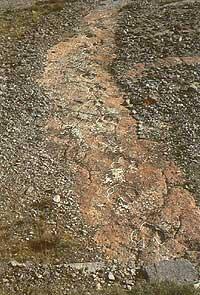
– Six have already been published in MUNIBE and four others are about to be published. However, to date they have been published: 1979 Enciso (La Rioja); 1980 Bretún (Soria); 1982 Munilla I (La Rioja); 1983 Santa Cruz de Yanguas (Soria); 1094 Munilla II (La Rioja) and 1985 Igea (La Rioja).
– Therefore, in the province of Soria there are also iknitas.– Yes, of course. For paleontology there are no administrative or similar limits. Currently, the WEALD de Cameros occupies half of La Rioja and half of Soria (from the capital of Logronio to the capital of Soria, approximately) and from west to east from the Navarra border to Burgos.
– What are the main discoveries made in these years?– A lot, and almost all very important. However, aside from Dinosaur research, some of the discoveries have been of great importance. We have made two new contributions to science: two new and interesting types of fossils. One of them is a small snail gastropod, of medium salty, adapted to live in fresh and salty waters. This new mollusc was discovered in Igea and was described and named by Doctors Menessier and Calzada at the ECIA in 1985. He was called Paraglauconia vierai in honor of his colleague Luis Inazio Viera.
The second fossil is a tree shaped fern that reached five meters in height. Studied by the paleobotanical doctor Barale, it is called Tempskya riojana in memory of La Rioja. In addition, this is the first reference of the Tempsky in the Iberian Peninsula, which until now has only been found in England, France, Russia and the United States.
– But as I have heard you, you have a new discovery.– Yes. Dinosaur skeleton. After many years of search and exploration we have found a fairly complete skeleton of a small herbivore dinosaur, the first of Cameros and for the unique moment. It belongs to the species Hypsilophodo n. This type of dinosaurs was a small corridor (1.70 meters long) and fast. It is well known in England for appearing in the strata of the time.
In the Iberian Peninsula only some fragments have been found. One of Teruel and another of Castellón, but this of Cameros is the most complete of all.
– So, just study the footsteps of Dinosaur. What other tracks have you found?– The truth is that when we investigate a territory we try to make it as complete as possible. The study of iknit is part of our work, but without the rest of geological and paleontological data it would not make sense.
Therefore, we begin with the stratigraphy of the place through a section or column. Then we collect all the paleontological data that we find by marking the guide lines, etc. All this allows us to know the environment in which the Dinosaurs lived.
– With these stratigraphy works, what conclusions have you drawn?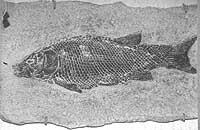
– Now, twelve years later, we know quite well the fauna and flora of the Cameros Dinosaurs.
In our publications we have placed long lists of organisms: microscopic ostracodos, giant dinosaurs, fresh water gasteropos such as Paludine, or saltwater such as Glauconia or Cerithio, Couscos such as clams, Unio and Teruella freshwater or Gaziodon.
We have also found remains of many fish: teeth, scales, vertebrae, etc. The most common fish is the so-called lepidote. It was a semi-armored fish that, with its strong teeth, fed on molluscs. They are also part of the Picnodontoe n group and the ancient Hybodus shark, which fights the most against each dorsal fin.
We have also collected remains of crocodiles: teeth, vertebrae and osteoderms (bone plates of your armored skin).
Also noteworthy are the residues of Turtle and Dinosaurs. Of the latter, and leaving aside the so-called Hypsilophodo n, we highlight the vertebrae of Suropod or the teeth of Megalosaurs carnivores.
– In dinosaur times, how was the landscape and environment of Cameros?– Very different from the current one. Now Cameros, in general, is a hard land, between 600 and 1,200 meters high, with a rocky and hard landscape. The vegetation is also scarce, with thorny plants such as thyme, rosemary and ulaga. That is why it is very appropriate for the geologist. In fact, not being covered with a strong plant layer, the rocks and strata of the area are perfectly visible.
125 million years ago, however, it was an extensive plain type Cameros delta, located at the same level as the sea that was on foot. Almost all of Euskal Herria was in the subsoil, and from there it came out.
To this vast plain came the rivers that brought eroded sediments in the continent. These sediments accumulated stratified forming the layers that can now be observed.
– And in that environment lived the Dinosaurs of La Rioja?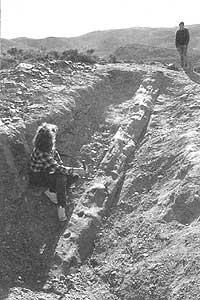
– Yes. All the species mentioned above lived on a plain of rivers, ponds and small lakes, as well as the Dinosaurs. These left their traces marked in mud and soft sands of background.
However, due to the delta there was a great relationship with the sea. Therefore, freshwater molluscs and saltwater molluscs are interspersed. The alteration of salinity also prevented the settlement of large plants and, sometimes, the large plant remains present rounded edges and erosions when transported by flotation in the water. We would especially quote a trunk of eleven meters in length. We find it in Igea and it seems to be of some conifer. It is currently protected by a fence placed by the town council and can be seen in it.
– And how did this flora affect the Mesozoic fauna?– In the absence of large plants and since the footsteps have been found in salty and sweet layers, it seems that the place of residence of the Dinosaurs (at least most) was not this. This would be a step. The delta plain seems to be the union of two paleogeographically higher territories. In these higher areas, there were also ferns of coniferous size and trees.

Gai honi buruzko eduki gehiago
Elhuyarrek garatutako teknologia




